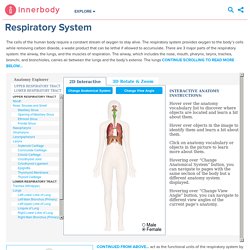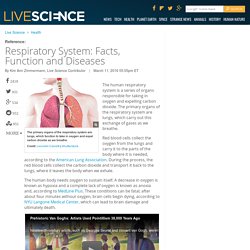

Michael Petrogeorge & Dallin Santistevan
Khanacademy. The Respiratory System - NHLBI, NIH. Interactive Anatomy Guide. The cells of the human body require a constant stream of oxygen to stay alive.

The respiratory system provides oxygen to the body’s cells while removing carbon dioxide, a waste product that can be lethal if allowed to accumulate. There are 3 major parts of the respiratory system: the airway, the lungs, and the muscles of respiration. The airway, which includes the nose, mouth, pharynx, larynx, trachea, bronchi, and bronchioles, carries air between the lungs and the body’s exterior. The lungs Continue Scrolling To Read More Below... Continued From Above... Anatomy of the Respiratory System Nose and Nasal Cavity The nose and nasal cavity form the main external opening for the respiratory system and are the first section of the body’s airway—the respiratory tract through which air moves. Mouth The mouth, also known as the oral cavity, is the secondary external opening for the respiratory tract. Pharynx Larynx Trachea Bronchi and Bronchioles Lungs Muscles of Respiration Pulmonary Ventilation.
Your Lungs & Respiratory System. Your lungs work with your respiratory system to allow you to take in fresh air, get rid of stale air, and even talk. Let's take a tour of the lungs! Locate Those Lungs Your lungs are in your chest, and are so big that they take up most of the space in there. You have two lungs, but they aren't the same size the way your eyes or nostrils are. Instead, the lung on the left side of your body is a bit smaller than the lung on the right.
Your lungs are protected by your rib cage, which is made up of 12 sets of ribs. You can't see your lungs, but it's easy to feel them in action: Put your hands on your chest and breathe in very deeply. A Look Inside the Lungs From the outside, lungs are pink and a bit squishy, like a sponge. Each main stem bronchus (say: BRONG-kuss) — the name for just one of the bronchi — then branches off into tubes, or bronchi, that get smaller and even smaller still, like branches on a big tree.
As you breathe in, your diaphragm contracts and flattens out. Waiting to Exhale. Respiratory System: Facts, Function and Diseases. The human respiratory system is a series of organs responsible for taking in oxygen and expelling carbon dioxide.

The primary organs of the respiratory system are lungs, which carry out this exchange of gases as we breathe. Red blood cells collect the oxygen from the lungs and carry it to the parts of the body where it is needed, according to the American Lung Association. During the process, the red blood cells collect the carbon dioxide and transport it back to the lungs, where it leaves the body when we exhale.
The human body needs oxygen to sustain itself. A decrease in oxygen is known as hypoxia and a complete lack of oxygen is known as anoxia and, according to MedLine Plus. Prehistoric Van Goghs: Artists Used Pointillism 38,000 Years Ago Nineteenth-century artists, such as Georges Seurat and Vincent van Gogh, weren't the first to use pointillism, according to a discovery of 38,000-year-old decorated limestone tablets in France.